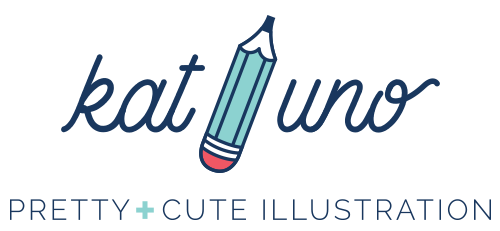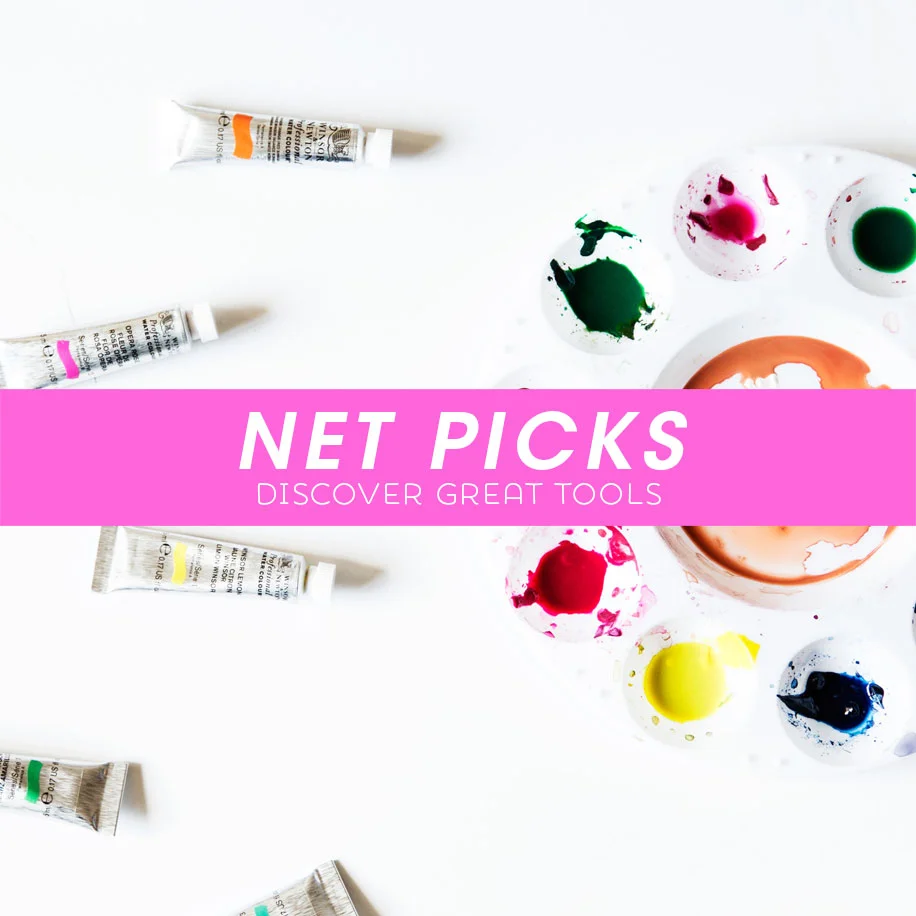Tools of the Trade – Adding Texture to Your Digital Work
Although I mainly use Adobe Illustrator to create my digital illustrations, I still want a more “natural” look instead of the sleek ,perfectly smooth edges you can achieve with vectors. I use a variety of methods to incorporate more texture into my vector work, both in Illustrator and in Photoshop.
How I Add Textures to My Work
Textures in Illustrator
I have several methods I use when adding textures and natural media touches in Illustrator. The first thing I usually do is add a stroke using a custom art brush on an object. A “stroke” is essentially an outline. I use purchased art brushes and also custom brushes I created myself. If you’ve never created your own art brushes in Illustrator before, I highly recommend you read this tutorial on Creative Market’s Design blog.
Adding a custom brush stroke around an object gives it a more hand drawn feel. Instead of a totally smooth edge/outline you'll see small bumps or curves that gives a bit more character to the flat shapes.
Next you can use hand drawn textures and then using the Image Trace option (in Illustrator CS6 and above). I usually will create a texture using pencils, pens, ink, stamps etc. Then I’ll scan and convert to a high contrast black and white image.
In Illustrator I’ll use the Image Trace option. After adjusting the options to get the image to where you like it, you need to go to “Object” > “Expand” so you can select the individual pieces. Double click on the expanded object to get it into isolation mode and then use the magic wand tool to select any white area. Then erase the white.
Now you can easily change the color of the texture and then overlay it onto different objects.
Transition to Photoshop
Although I use Illustrator to build my objects, Photoshop is the go to program I use to compose, paint and finalize my illustrations. Disclaimer: I usually will create the flat objects in Illustrator and then cut and paste each element into a Photoshop file as a Smart Object (from Photoshop CS2 and up). I like importing my vector objects this way because if you paste it as a Smart Object it will retain it’s vector status. This is important because if you want to resize the object (mainly for enlarging) you can do so without worry about pixilation or blurriness that happens when enlargine a raster image.
I am not sure if there is a way to export an Illustrator file to Photoshop and preserve the layers AND the vector information. That is why I use the labor intensive method of cutting and pasting each object (sometimes I’ll paste a group if I don’t think I’ll need to work on anything separately) and then reconstruct the layout in Photoshop.
Ok, so back to my vector textures. In Photoshop you have a lot more options of how you can overlay the textures. You can use layer effects to change how they interact with the layers underneath, you can use clipping masks to easily contain the texture to the element that is masking it.
In addition to the vector textures you created, you can also add textures using custom Photoshop brushes, scans of watercolor washes or ink splatters and even just simple gradients.
Check out this great tutorial from RetroSupply on how to create your own custom Photoshop brushes.
I highly recommend this Skillshare class by Lydia Nichols on how she uses both Illustrator and Photoshop to compose her work. She goes much more in depth (with videos!) on her process.
If creating your own custom brushes and textures isn’t your cup of tea, here are some great sources where you can get quality digital tools.
Illustrator Resources:
RetroSupply Co.’s VectorSupply – this is a pack of different vector textures. Included are scanned textures, both art and scatter brushes, and texture pattern swatches (that repeat!). This is a great starter pack for someone that wants to try out vector textures.
RetroSupply Co.’s VectorHero Bushes – This is an extensive pack of 40 art brushes. 20 are “cleaner” inking brushes for natural but smooth lines and 20 are “dirty” ink brushes that give more character and texture to the strokes. 40 brushes is definitely a good selection (I think I work mainly in about 5-10 favorite brushes myself) so for the price, this is a great selection.
Ink Age Brush Pack by Guerillacraft – The amount of brushes you get for under $10 is amazing. Just note that these are not solid brushes, they give more of a “leaky” brush look but they are great for creating a vintage, hand drawn look.
Lemonade Pixels’s Vector Grunge Textures – For a small investment you can get a nice variety of vector textures. From bold to subtle, there is a nice diverse collection of textures which are already in vector!
Nicky Laatz has a Give Me Watercolour in Illustrator! bundle which is a pack of vector watercolor patterns! These are actually really cool because these are seamless patterns! That means you can create a shape of any size and add these patterns to it and it will be filled seamlessly. Since they are vector, you can size up or down without any distortion or loss of image quality. Along with the watercolor patterns, she also includes 115 hand drawn vector illustrations that you can either use as is or fill with the watercolor patterns!
Photoshop Resources:
Ok, for brushes, I pretty much only use Kyle Webster’s Photoshop brushes. I used to try other brushes before but these are awesome! He has a large collection. I personally have his Megapack for Photoshop (that has over 160 brushes) and his Runny Inkers set (which give a great drippy inky pen personality to your line drawings. He also has a few free brushes you can get via his Gumroad page. Of the free brushes, I really like his Wet & Wild Watercolor brush and his Pastel Palooza brush. If you’d like to see these brushes in action before purchasing, check out his YouTube channel! It’s important to note that his brushes will only work in Photoshop CS5 and higher.
I LOVE Nicky Laatz’s watercolor texture packs! Her Give me Watercolour Textures Quick! Pack is a great starter pack full of beautifully painted textures. I love layering these onto my artwork to give added texture and color variation.
Although I rely mainly on Photoshop brushes and watercolor scans for texturing, I think it’s always good to have a general subtle/grunge texture pack. I recommend David Larusso’s 30 Subtle & Grunge Textures pack. A great value for under $10 and the variety is nice. I like how the textures are very subtle because you can build up the textures with layers without being too in your face.
Ink Pad by Vintage Design Co - is a great tool for adding texture. It gives a stamp-like effect which is cool for layering. It's really easy to use but if you are new to Photoshop I would suggest getting familiar with smart objects and using layer styles. Instructions are included though so don't worry!
Supergrain by RetroSupply Co. - This is another great tool for adding texture. Similar to Ink Pad but there are different effects you can get. Detailed instructions are included so although there may be lots of options, it should be easy enough to learn to use.
More Sources:
Creative Market - Lots of different digital assets on sale here. Every week they also have 6 free goods that they give away so you can try them out. That's what I did and now I'm a loyal customer!
Design Cuts - Design Cuts recently changed their business model from only selling heavily discounted curated digital bundles to a new marketplace system. Their current system allows you to build your own bundles, the more you buy the more you save. You can save from 20% off two items to up to 50% off 5 or more items! They also have a freebie section on their site that you can download and test out some of their products. They do still offer curated bundles which are only available for a short period of time. These rotate on a biweekly basis. I'm a fan of Design Cuts and I've bought a lot of great tools (in bundle format) from them in the past.
Do you use textures in your artwork? Do you have any favorite digital tools that you use? Please drop me a line and let me know if you have any resources you'd like to share!
RELATED POST:
Net Picks - Favorite Tools: In this post I share a few of my favorite digital tools I use in my artwork and a few samples that showcase what I used those tools for.
*Disclaimer: Although I am an Creative Market Affiliate, this is not a sponsored post. I only receive revenue when someone makes a purchase from my affiliate sites.

